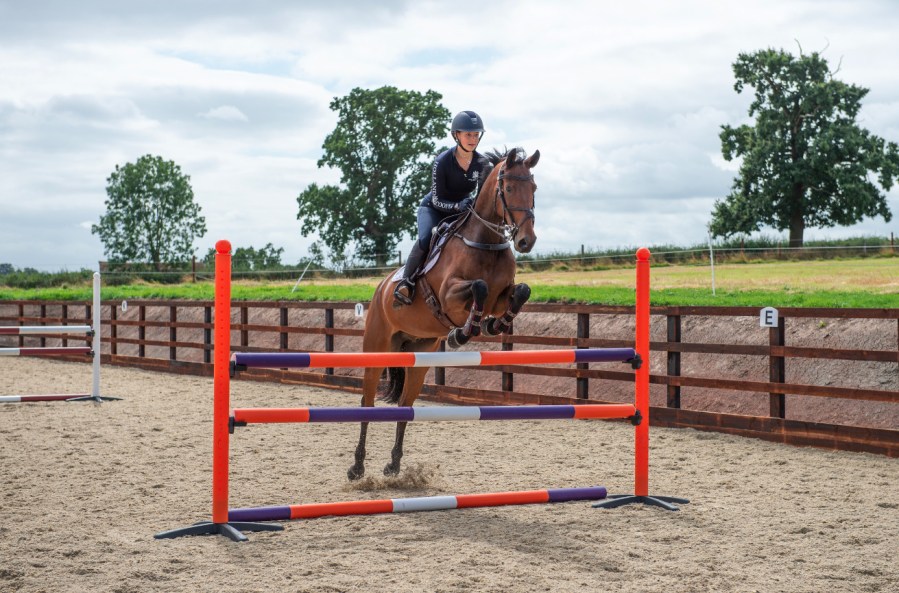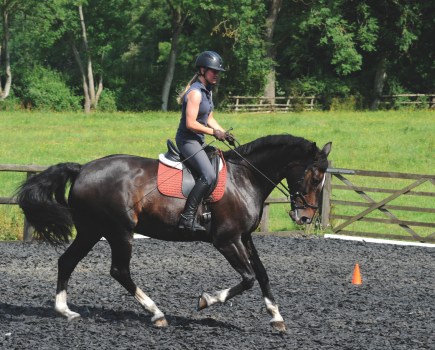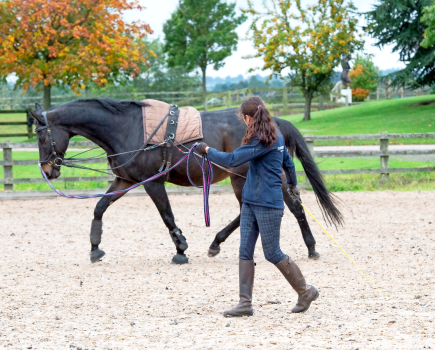There’s no feeling quite like soaring over a jump on your horse, but euphoria soon turns to despair if they refuse a fence. Riding a horse who frequently refuses not only dashes any hopes of a clear round, but it can also knock your confidence. If this sounds familiar, it’s time to take everything back a step and re-establish the basics.
Here, UKCC Level 3 showjumping coach Jemma Whitlam shares how you can work out why your horse is refusing fences, and then what to do about it. Whether they lack confidence or have learned to refuse, you’ll soon be flying over fences and make penalties a thing of the past with these training tips.
Identify the problem
Once you’ve ruled out pain by having their back, teeth and tack checked, and a vet has cleared your horse to ride, it can be time to address refusals through training. According to Jemma, there are three main problems that could be causing your horse to slam on the brakes ahead of a jump:
1 Poor canter quality
“One reason is that the quality of your canter isn’t good enough,” she says. “Often people are in a rush to get to fences, but it’s important to slow things down and give your horse time to think. You want a canter that’s big and bouncy, rather than flat and fast.”
2 You’re in the wrong position
“Another problem could be your jumping position. A lot of people see a stride a long way from the fence and fold too early. It gives your horse the opportunity to go out the side door.”
3 Your horse is spooky
The third reason could be that your horse is spooky. Perhaps he’s happy with a simple cross-pole, but not so sure when it comes to adding in fillers.
“A lot of people forget about the process when it comes to increasing the difficulty of jumps,” explains Jemma. “They might try a different type of fence for the first time by charging at it. It doesn’t give your horse time to think and he backs off. You need to approach new fences in a controlled way.”
Exercise 1: Control the canter
It’s common to steady your horse when turning for a fence and then race towards it once you’ve found your line, but this could be setting you up for a refusal.
“If you slow your horse down when you turn, you could be losing power,” explains Jemma. “The key is to push him on and have a canter that’s longer and more powerful, but not necessarily faster. Then, when you straight up, you need to be able to control his stride towards the fence.
“Give yourself time. The more you rush, the less chance you have to keep your horse straight on the approach.”
Set it up
Place two poles on the ground 19 yard (17.5m) apart down one side of your school or paddock. In the middle of the two poles, place a set of tramlines.
How to ride it
- Go large in canter around your school on the right rein.
- At the end of the school that’s closest to the first pole, canter a 20m circle.
- Establish a good canter, pushing your horse on to make his canter longer, but not faster. Think of it as adding energy rather than speed.
- Maintain this canter as you look for the poles.
- Turn towards your first pole, keeping your horse straight and between your leg and hand.
- Canter over the pole, riding straight between the tramlines and counting four strides to the second pole.
- Ride over the second pole and return to the track.
- Repeat until you’re confidently maintaining an even canter.
- Change the rein and ride over the poles in the other direction.
The next level
Adapt your horse’s canter and change the number of strides you fit in between the poles. Lengthen and aim for three, or shorten for five or six.
Exercise 2: Improve your position
Predicting where your horse will take off for a jump is a skin in itself. Thinking he’s going to take off before he does can actually give him the opportunity to refuse.
“If you see a stride a long way from a fence and fold too early, you risk a run-out or refusal,” says Jemma. “To fix this, you need to be braver. Sit up and ride deeper into the fence and wait for your horse to take you into the jumping position.”
Set it up
Place two jumps – a cross-pole and an upright at a height you’re comfortable with – 10 yards (9m) apart in the centre of your arena. Place a ground pole three yards in front of the cross-pole.
How to ride it
- Go large around your school or paddock in trot on the left rein.
- Look ahead for your first fence and trot to the ground pole.
- Pick up canter over the pole and keep your body upright.
- As your horse leaves the ground for the cross-pole, fold into your jumping position.
- After the fence, sit up quickly and ride straight to the upright.
- Jump it and return to the track.
- Repeat on the other rein.
Back to basics
Start with the second fence as a cross-pole too, and change it into an upright when you feel confident.
Exercise 3: Say no to spooking
When you’re riding a youngster or a horse who’s less experienced, spooking at fences is a common issue. “When you’re attempting something new with your horse, remember learning is a slow process,” advises Jemma. “Do everything gradually and don’t be afraid to take a step back if needed.”
Set it up
Place an upright in the centre of your school. Find two fillers and place them either side of your fence.
How to ride it
- Go large and establish a good canter with plenty of energy, just as you did in exercise one.
- Turn up the centre line and look ahead for your jump, aiming for the middle.
- Jump the fence.
- Ride straight towards the outside track.
- Go large and ask a friend to pull the fillers slightly closer towards the centre of the jump.
- Jump the fence as before.
The next level
Gradually move the fillers closer towards the centre of the jump until your horse feels confident clearing them. If he’s ever unsure, take things back a step by moving them out towards the sides again. If needed, use guide poles on top of the jump to help your horse focus and stay straight.
Jemma Whitlam is a UKCC Level 3 showjumping coach. She is based on the Northamptonshire/ Leicestershire border and also coaches dressage and cross country.









